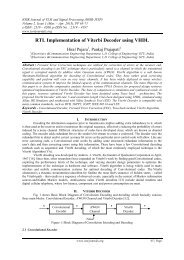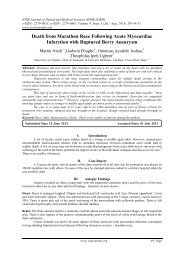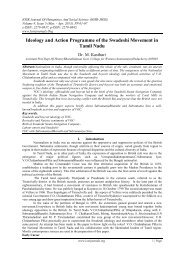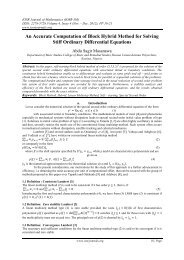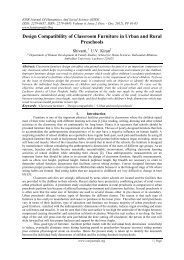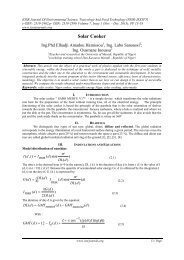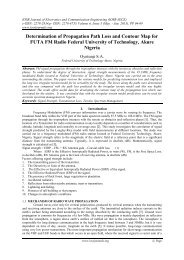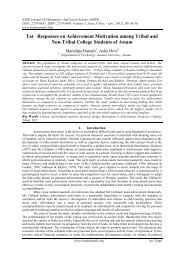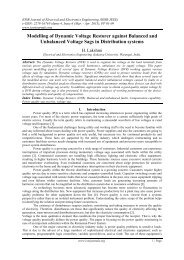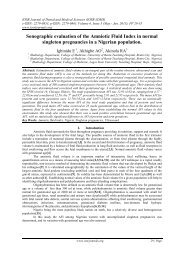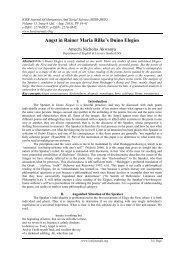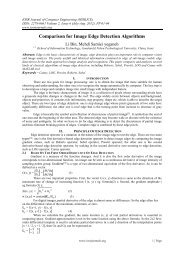Estrogen And Progesterone Receptors In Dysfunctional ... - IOSR
Estrogen And Progesterone Receptors In Dysfunctional ... - IOSR
Estrogen And Progesterone Receptors In Dysfunctional ... - IOSR
You also want an ePaper? Increase the reach of your titles
YUMPU automatically turns print PDFs into web optimized ePapers that Google loves.
<strong>IOSR</strong> Journal of Dental and Medical Sciences (<strong>IOSR</strong>-JDMS)<br />
e-ISSN: 2279-0853, p-ISSN: 2279-0861. Volume 4, Issue 3 (Jan.- Feb. 2013), PP 73-76<br />
www.iosrjournals.org<br />
<strong>Estrogen</strong> <strong>And</strong> <strong>Progesterone</strong> <strong>Receptors</strong> <strong>In</strong> <strong>Dysfunctional</strong> Uterine<br />
Bleeding<br />
Dr. V. Kalyan Chakravarthy M.D 1 , Dr. Usha Nag M.D 2 ,<br />
Dr. D. Ranga Rao M.D 3 , Dr. A.M. Anusha 4<br />
1 (Department of Pathology, Dr. Pinnamaneni Siddhartha <strong>In</strong>stitute of Medical Sciences & R.F, INDIA)<br />
2 (Department of OBG, Dr. Pinnamaneni Siddhartha <strong>In</strong>stitute of Medical Sciences & R.F, INDIA)<br />
3 (Department of Pathology, Dr. Pinnamaneni Siddhartha <strong>In</strong>stitute of Medical Sciences & R.F, INDIA)<br />
4 (Department of Pathology, Dr. Pinnamaneni Siddhartha <strong>In</strong>stitute of Medical Sciences & R.F, INDIA)<br />
Abstract: Objective: To analyze estrogen and progesterone receptors(ER, PR) in various histopathological<br />
patterns in relation to circulating estradiol levels in patients with dysfunctional uterine bleeding.<br />
Material Methods: 60 patients diagnosed to have dysfunctional uterine bleeding (DUB) were studied. All of<br />
them had increased amount of bleeding during menses. Any case with a known cause of bleeding was not<br />
included in the study. A strict criterion for the definition of DUB was maintained. Serum estradiol levels were<br />
estimated by Immunoflorescence technique. Dilatation and curettage was done and sent for histopathological<br />
examination and immunohistochemistry for estrogen and progesterone receptors. The histopathology report<br />
was correlated with the estradiol levels and ER, PR status.<br />
Result: Estradiol levels were increased in disordered proliferation, simple cystic hyperplasia and irregular<br />
ripening and very high in complex adenomatous hyperplasia and were high normal in patients diagnosed as<br />
proliferative phase and secretory phase. <strong>In</strong> this study ER and PR levels were increased in hyperplasias and<br />
endometrial carcinomas.<br />
Conclusion: Estradiol levels were high in patients with dysfunctional bleeding and range varied according to<br />
different levels of hyperplasia and is a useful parameter to establish the etiology and in treatment.<br />
Key words: disordered proliferation, dysfunctional bleeding, estradiol.<br />
I. <strong>In</strong>troduction<br />
About 90% of cases of DUB are anovulatory and 10% ovulatory 1 . During an anovulatory cycle, the<br />
corpus luteum does not form. Thus, the normal cyclical secretion of progesterone does not occur, and estrogen<br />
stimulates the endometrium unopposed 2 . Without progesterone, the endometrium continues to proliferate,<br />
eventually outgrowing its blood supply; it then sloughs and bleeds incompletely, irregularly, and sometimes<br />
profusely or for a long time. When this abnormal process occurs repeatedly, the endometrium can become<br />
hyperplastic, sometimes with atypical or cancerous cells 3 . Anovulatory DUB can result secondary to PCOS and<br />
hypothyroidism 4 .<br />
An acute bleeding episode is best controlled with high-dose estrogen. Treatment of chronic, repetitive,<br />
bleeding problems may consist of hormonal therapy with estrogen and progestin or cyclical progestin alone.<br />
Surgery may be needed if hormone therapy fails. Surgical options include dilation and curettage (D&C), laser or<br />
electrocauterization, endometrial ablation, or hysterectomy 4 . Circulating blood levels of estrogen and<br />
progesterone have implications on DUB 7 . A few studies have shown that DUB has high estradiol levels 8 . The<br />
estrogen receptor (ER) and progesterone receptor (PR) expression and distribution pattern might play an<br />
important role in normal endometrial function. Receptor studies in DUB cases show that ER and PR levels in<br />
DUB patients were significantly higher 8 . Morphometric analysis included gland shape, lumen/gland relative<br />
volume, gland: stroma ratio and number of capillaries/mm 2 stroma 9 .<br />
<strong>In</strong> this study we have evaluated the histopathological features of endometrium in correlation with<br />
hormone levels and with special emphasis on receptors and morphometry in the diagnosis of menorrhagia.<br />
II. Material <strong>And</strong> Methods<br />
The present study is a one year prospective study carried out in our hospital. The material for the<br />
present study was collected from patients who attended Department of Obstetrics and Gynecology and<br />
diagnosed clinically to have dysfunctional uterine bleeding. The selection criteria included a meticulous<br />
examination to rule out any known cause of excessive bleeding, thus strictly adhering to the definition of DUB.<br />
All the patients were subjected to Ultra sonogram to rule out any known pathology. Dilatation and curettage was<br />
done under local anesthesia and material sent for histopathological study with complete clinical details. The<br />
same day blood was collected for estradiol estimation. Serum estradiol levels were estimated by<br />
www.iosrjournals.org<br />
73 | Page
<strong>Estrogen</strong> <strong>And</strong> <strong>Progesterone</strong> <strong>Receptors</strong> <strong>In</strong> <strong>Dysfunctional</strong> Uterine Bleeding<br />
Immunoflorescence technique. The histopathology report was then correlated with the estradiol levels.<br />
Estimation of ER & PR receptors were done using leica reagents. Morphometric analysis of glands and stroma<br />
were done with appropriate controls. The results of histopathology, LMP, Estradiol levels, special stains and<br />
ER, PR receptors were correlated and analyzed to conclude the cause of menorrhagia. The analyzed data was<br />
compared with other series in literature and discussed.<br />
The data is tabulated and analysed using Chi-Square test. P value of 20=5+) was increased in disordered proliferation,<br />
simple endometrial hyperplasia and very high in complex endometrial hyperplasia and endometrial carcinoma.<br />
Gland: stroma ratio was very high in simple endometrial hyperplasia, complex endometrial hyperplasia and<br />
endometrial carcinoma.<br />
The most common glands seen were cylindrical. Simple endometrial hyperplasia, complex endometrial<br />
hyperplasia and endometrial carcinoma had ramified glands.<br />
Simple endometrial hyperplasia, complex endometrial hyperplasia and endometrial carcinoma had increased<br />
lumen/gland relative volume and showed increased number capillaries/mm 2 stroma.<br />
IV. Discussion<br />
Menstrual disorders are common, accounting for almost 3% of all outpatient referrals and over 20% of<br />
referrals to gynecology outpatients’ clinics. 1 <strong>In</strong> this study the maximum age incidence of patients suffering from<br />
menorrhagia was between 31-40 years. Pilli GS et al 2 , Madiha Sajjad 3 et al and Archana 4 et al reported that the<br />
common age incidence was between 40-50 years, while Sadia Khan 5 et al reported as 45-55, Shazia Riaz et al 6<br />
as 45-50 and Layla et al 7 more then 52.<br />
Studies done<br />
Age incidence<br />
Sadia Khan 5 (2011) 45-55<br />
Layla 7 (2011) >52<br />
Madiha Sajjad 3 (2011) 40-50<br />
Shazia Riaz 6 (2010) 45-49<br />
Archana 4 (2010) 40-50<br />
Present study 31-40<br />
<strong>In</strong> this study the most common pattern seen was proliferative phase (40%). Pilli GS et al 2 reported endometrial<br />
hyperplasia as most common (44%), while Sadia Khan et al 5 reported proliferative phase (46%), Shazia Riaz 6<br />
(33%), Archana et al 4 (53%). Layla et al 7 reported secretory phase in 24% of cases.<br />
Studies done Endometrial patterns Percentage<br />
Sadia Khan 5 (2011) Proliferative phase 46<br />
Layla 7 (2011) Secretory phase 24<br />
Shazia Riaz 6 (2010) Proliferative phase 33<br />
Archana 4 (2010) Proliferative phase 53<br />
Present study Proliferative endometrium 40<br />
www.iosrjournals.org<br />
74 | Page
<strong>Estrogen</strong> <strong>And</strong> <strong>Progesterone</strong> <strong>Receptors</strong> <strong>In</strong> <strong>Dysfunctional</strong> Uterine Bleeding<br />
<strong>In</strong> this study serum estradiol levels were high in simple endometrial hyperplasia and complex endometrial<br />
hyperplasia and very high in endometrial carcinoma. Vysotskiĭ MM et al 8 reported high estradiol levels were<br />
detected in the blood sera of patients with glandular cystic polyps, atypical and glandular hyperplasia. Gorchev<br />
G 9 et al found normal and decreased estradiol levels in atypical hyperplasia and endometrial carcinoma. Lépine<br />
J et al 10 stated that circulating levels of estradiol levels were significantly higher in endometrial carcinoma<br />
compared to normal endometrium. Mülayim B 11 et al reported serum estradiol levels were significantly higher in<br />
perimenopausal women with menometrorrhagia. Moen MH 12 et al stated that estradiol levels are increased in<br />
perimenopausal women with menometrorrhagia.<br />
<strong>In</strong> this study PAS stain didn’t show any advantage when compared to H & E. Hong Yul Choi 13 et al<br />
reported that secretory substance in the epithelial cells of the endometrial glands during the secretory phase and<br />
menstrual phase was mainly glycogen and concluded that PAS staining is superior to routine hematoxylin and<br />
eosin staining for the detection of epithelial secretory substance. Eddie SM 14 et al stated that PAS stain is<br />
superior to H & E.<br />
<strong>In</strong> this study mitotic index, gland: stroma ratio, lumen/gland relative volume and number of<br />
capillaries/mm2 stroma were increased in simple, complex endometrial hyperplasia and endometrial carcinoma.<br />
Dunton C 15 et al reported that simple endometrial hyperplasia have few mitoses, increased number of glands<br />
relative to stroma. <strong>In</strong> complex endometrial hyperplasia mitoses are typically present; the gland-to-stroma ratio is<br />
higher compared to simple hyperplasia. Kendal BS 16 et al stated that endometrial carcinoma showed high gland:<br />
stroma ratio and increased mitoses. Elyzabeth Avvad 17 et al reported that volume density was greater in simple<br />
hyperplasia than in proliferative endometrium. <strong>In</strong> simple hyperplasia the glands usually have a tendency to be<br />
crowded and with great diameters (luminal dilatation). Baak 18 et al stated that volume density decreases in<br />
atypical hyperplasia and well-differentiated adenocarcinoma of the endometrium.<br />
<strong>In</strong> this study ER and PR levels were increased in hyperplasias and endometrial carcinomas. Spona J 19 et<br />
al stated that receptor levels were highest in well-differentiated group of endometrial carcinoma. Hu K 20 et al<br />
reported decreased levels of estrogen receptors in both atypical hyperplasia and adenocarcinoma. Teleman S 21 et<br />
al reported high level of both ER and PR in simple and complex hyperplasias and a significant decrease in<br />
atypical hyperplasia. Nyholm HC 22 et al stated that adenomatous hyperplasia have high progesterone receptor<br />
levels. Guo Y 23 et al reported that ER and PR rates in adenocarcinoma were higher than in the normal<br />
histological types. Samhita Chakraborty 24 et al reported increased levels of ER and PR levels in DUB cases.<br />
V. Conclusion<br />
An imbalance of the hormones leads to abnormal uterine bleeding and also endometrial carcinoma. <strong>In</strong><br />
our study ER and PR levels were very high in simple and complex endometrial hyperplasia & endometrial<br />
carcinoma. It was slightly increased in disordered proliferation and irregular shedding and almost normal in<br />
secretory and proliferative endometrium. Thus ER and PR levels shown to be increased in endometrial<br />
carcinomas have been associated with well differentiated tumor phenotype and treatment options are determined<br />
on the basis of their levels. Finally stepwise evidence - based approach to managing menorrhagia is<br />
recommended. Medical management is considered first line in the treatment of menorrhagia. Oral contraceptive<br />
pills, patches, vaginal rings, cyclic progestins or levonorgestrel IUD may be utilized to regulate menses. When<br />
medical management fails, surgical options that may be considered include operative hysteroscopy with<br />
endometrial resection, endometrial ablation, uterine artery embolization or hysterectomy.<br />
References<br />
[1] Coulter A, Bradlow J, Agass M, Martin-Bates C, and Tulloch A. Outcomes of referrals to gynecology outpatient clinics for<br />
menstrual problems: An audit of general practice records. Brit J Obstet Gynaecol 1991; 98: 789-96.<br />
[2] Pilli GS, Sethi B, Dhaded AV, Mathur PR. <strong>Dysfunctional</strong> uterine bleeding (Study of 100 cases). J of Obst and Gyn of <strong>In</strong>dia 2002;<br />
52(3): 87-89.<br />
[3] Madiha et al. Pathological findings in hysterectomy specimens of patients presenting with menorrhagia in different age groups.<br />
Ann Pak <strong>In</strong>st Med Sci Jul - Sep 2011; 7(3):160-2.<br />
[4] Archana Bhosle et al. Evaluation and Histopathological Correlation of Abnormal Uterine Bleeding in Perimenopausal Women.<br />
Bombay Hospital Journal, Vol. 52, No. 1, 2010.<br />
[5] Sadia Khan et al. Histopathological Pattern of Endometrium on Diagnostic D and C in Patients with Abnormal Uterine Bleeding.<br />
Annals vol 17. No. 2 Apr. – Jun. 2011.<br />
[6] Shazia Riaz et al. Endometrial Pathology by Endometrial Curettage in Menorrhagia in Premenopausal Age Group. J Ayub Med<br />
Coll Abbottabad 2010;22(3)<br />
[7] Layla S Abdullah. Histopathological Pattern of Endometrial Sampling Performed for Abnormal Uterine Bleeding. Bahrain<br />
Medical Bulletin, Vol. 33, No. 4, December 2011.<br />
[8] Vysotskii MM et al. The pathogenetic basis for using antiestrogens in treating patients with hyperplastic processes of the<br />
endometrium in the postmenopause. Akush Ginekol. 1993 ;( 6):46-9.<br />
[9] Gorchev G et al. Serum E2 and progesterone levels in patients with atypical hyperplasia and endometrial carcinoma. Akush<br />
Ginekol. 1993; 32(2):23-4.<br />
[10] Lepine J et al. Circulating estrogens in endometrial cancer cases and their relationship with tissue expression of key estrogen<br />
biosynthesis and metabolic pathways. J Clin Endocrinol Metab. 2010 Jun; 95(6):2689-98. Epub 2010 Apr 6.<br />
www.iosrjournals.org<br />
75 | Page
<strong>Estrogen</strong> <strong>And</strong> <strong>Progesterone</strong> <strong>Receptors</strong> <strong>In</strong> <strong>Dysfunctional</strong> Uterine Bleeding<br />
[11] Mulayim B et al. The Relation of Serum <strong>In</strong>hibin B, Estradiol and FSH Levels to Menometrorrhagia in Perimenopausal Women. J<br />
Turkish-German Gynecol Assoc, Vol. 9(3); 2008:149-151.<br />
[12] Moen MH, Kahn H, Bjerve KS, Halvorsen TB. Menometrorrhagia in the perimenopause is associated with increased serum<br />
estradiol. Maturitas. 2004; 47:151-5.<br />
[13] Choi HY, Lee YB, Kim DS. Histochemical Studies of Human Endometrium with Special Emphasis on Secretory Activity and<br />
Ovulation. Yonsei Med J. Dec 1966; 7(1):7-12.<br />
[14] Eddie Moore et al. A Histochemical Study of Endometrial and Aborted Placental Tissue. Journal Of The National Medical<br />
Association January, 1962, Vol. 54, No. 1 31<br />
[15] Dunton C, Baak J, Palazzo J et al. Use of computerized morphometric analyses of endometrial hyperplasias in the prediction of<br />
coexistent cancer. Am J Obstet Gynecol 174:1518, 1996<br />
[16] Kendall BS, Ronnett B M, Isacson C et al. Reproducibility of the diagnosis of endometrial hyperplasia, atypical hyperplasia, and<br />
well-differentiated carcinoma. Am J Surg Pathol 1998; 22:1012.<br />
[17] Elyzabeth. Simple hyperplasia versus proliferative endometrium: stereological study. J. Bras. Patol. Med. Lab. 2003, vol.39, n.1,<br />
pp. 73-79.<br />
[18] Baak JPA. The role of computerized morphometric and cytometric feature analysis in endometrial hyperplasia and cancer<br />
prognosis. J. Cell. Bioch. Supplement 23:137-146, 1995.<br />
[19] Spona J et al. Hormone serum levels and hormone receptor contents of endometria in women with normal menstrual cycles and<br />
patients bearing endometrial carcinoma. Gynecol Obstet <strong>In</strong>vest. 1979; 10(2-3):71-80.<br />
[20] Hu K et al. Expression of estrogen receptors ERalpha and ERbeta in endometrial hyperplasia and adenocarcinoma. <strong>In</strong>t J Gynecol<br />
Cancer. 2005 May-Jun; 15(3):537-41.<br />
[21] Teleman S et al. An immunohistochemical study of the steroid hormone receptors in endometrial hyperplasia. Rev Med Chir Soc<br />
Med Nat Iasi. 1999 Jan-Jun; 103(1-2):138-41.<br />
[22] Nyholm HC et al. Biochemical and immunohistochemical estrogen and progesterone receptors in adenomatous hyperplasia and<br />
endometrial carcinoma: correlations with stage and other clinicopathologic features. Am J Obstet Gynecol. 1992 Nov;<br />
167(5):1334-42.<br />
[23] Guo Y et al. <strong>Estrogen</strong> and progesterone receptors in endometrial carcinoma. Zhonghua Fu Chan Ke Za Zhi. 1997 Jul; 32(7):418-<br />
21.<br />
[24] Samhita Chakraborty et al. Endometrial hormone receptors in women with dysfunctional uterine bleeding. Archives Of<br />
Gynecology <strong>And</strong> Obstetrics Volume 272, Number 1, 17-22, 2005.<br />
www.iosrjournals.org<br />
76 | Page



